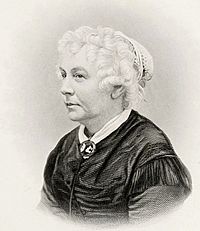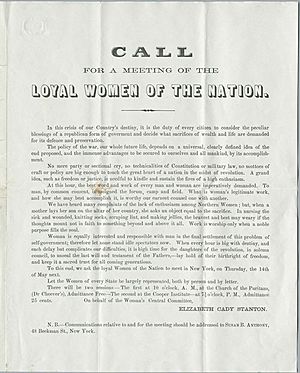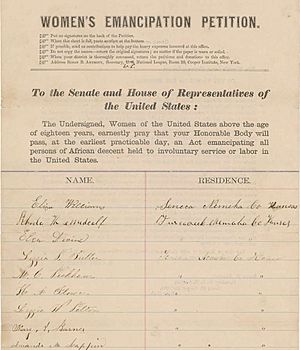Women's Loyal National League facts for kids
The Women's Loyal National League was a special group formed on May 14, 1863. Its main goal was to end slavery in the United States. This group was led by two important women, Elizabeth Cady Stanton and Susan B. Anthony. Stanton was the president, and Anthony was the secretary.
The League organized the biggest petition drive in the country's history at that time. They gathered almost 400,000 signatures from people who wanted to abolish slavery. These petitions were sent to the U.S. Congress. Their efforts greatly helped pass the Thirteenth Amendment, which officially ended slavery in the U.S. The League stopped its work in August 1864 when it was clear the amendment would pass.
This group was the first national political organization for women in the United States. It showed how women's activism was changing. They moved from just talking about issues to taking direct political action. The League also helped new leaders and activists grow within the women's movement.
Contents
History of the Women's Loyal National League
Forming the League: A Call to Action
The Women's Loyal National League started on May 14, 1863, in New York City. Its purpose was to gather support for a new amendment to the U.S. Constitution. This amendment would make slavery illegal everywhere. At this time, the American Civil War was happening, and slavery was a major reason for the war.
Elizabeth Cady Stanton and Susan B. Anthony organized the first meeting of the League. Both women are famous for fighting for women's rights. However, during the Civil War, leaders of the women's movement decided to pause their work on women's rights. Instead, they focused on ending slavery. Anthony had already worked for the American Anti-Slavery Society. Stanton's husband also worked for the same organization. So, they were both familiar with the fight against slavery.
Why the Name "Loyal National League"?
The League's name showed its support for the Union during the Civil War. Many groups called "Union Leagues" or "Loyal Leagues" were formed to encourage loyalty. The Emancipation Proclamation had freed enslaved people in states that were fighting against the Union. But it did not free them everywhere.
Some groups, like the Loyal League of Union Citizens, supported the government in stopping the rebellion. Another group, the Loyal National League, wanted to free enslaved people in all states. Elizabeth Cady Stanton and Susan B. Anthony were encouraged by their male friends and family who were also abolitionists. They created their own organization, similar in name and goal, but with a focus on women's involvement.
Starting the Movement: Appeals and Resolutions
Stanton and Anthony prepared for the new organization by writing an "Appeal to the Women of the Republic." This appeal was published in the New York Tribune, a newspaper that was against slavery. They also shared a pamphlet with this appeal and the invitation to the convention.
Anthony opened the convention and suggested Lucy Stone, another important women's rights activist, lead the meeting. Stanton gave the main speech. Other well-known women's rights figures were also there. These included Martha Coffin Wright, Amy Post, Antoinette Brown Blackwell, Ernestine Rose, and Angelina Grimké Weld.
Anthony gave a short speech and introduced several ideas. She said, "There is great fear expressed on all sides lest this shall be made a war for the negro. I am willing that it shall be." She believed the war should be about establishing freedom for all.
One of her ideas stated that there could be no true peace until all citizens, including African Americans and women, had equal rights. Some people at the meeting did not like this idea. They thought it brought up women's rights, which they felt was not the main goal. However, the idea was approved by most attendees.
Stanton was chosen as the League's president, and Anthony became its secretary. Their office was located in the new Cooper Union building in New York City.
The Great Petition Drive
The League started a huge petition drive. They used their connections from their past work in the abolitionist and women's movements. They collected almost 400,000 signatures. These petitions asked the U.S. Congress to pass an amendment to end slavery.
This was the largest petition campaign in the nation's history up to that time. About one out of every twenty-four adults in the Northern states signed a petition. Anthony was the main organizer of this effort. She worked with 2,000 people who helped collect signatures.
U.S. Senator Charles Sumner, a strong supporter of the League in Congress, presented the first 100,000 petitions. He made a dramatic show of it. Two Black men carried the petitions, which had been glued together to form a very long roll, onto the Senate floor. Senator Sumner then continued to deliver large groups of petitions as they arrived.
Funding and Key People
The petition drive was paid for by donations from the people who signed the petitions and from other supporters. The League also raised money by selling pins. These pins had the words "In Emancipation is National Unity" and showed an enslaved person breaking their chains.
The Hovey Fund, which came from a supporter of abolition and women's rights, paid Anthony's salary. She earned $12 per week. Anthony did not have other income, so she lived with the Stanton family to save money. The League also hired an office clerk and two field agents. These agents were Hannah Tracy Cutler and Josephine S. Griffing. Both were active in the abolitionist and women's rights movements.
The League's Second Convention and End
The League held its second national meeting in New York City on May 12, 1864. At this meeting, they passed a resolution asking for Black men to have voting rights. They also wanted Black men to be able to serve as soldiers, sailors, and laborers with equal pay. Another resolution called for women in medicine to be paid the same as men doing the same work.
Slavery in the U.S. was ended in 1865 by the Thirteenth Amendment. In August 1864, it became clear that the amendment would be approved. The League decided its work was done and closed its office.
Significance of the Women's Loyal National League
First National Women's Political Group
The Women's Loyal National League was the first national political organization for women in the United States. It showed how important it was for women's groups to be well-organized. Before the Civil War, the women's rights movement was not very structured. It had only a few state groups and no national organization.
The League's petition drive marked a big change in how women took action. They moved from simply trying to persuade people with moral arguments to taking direct political steps. This group played a significant role in helping to pass the Thirteenth Amendment, which abolished slavery in the U.S.
Developing New Leaders
The League helped develop a new generation of women leaders in the fight against slavery. It gave important experience and recognition to Stanton and Anthony. It also helped new activists like Anna Dickinson, who was a talented teenage speaker.
The League had 5,000 members, and 2,000 of them actively collected petitions. This created a large network of women activists. They gained valuable experience that helped them become leaders in future social movements.
The League also provided a way for the women's movement to combine the fight against slavery with the fight for women's rights. They reminded the public that petitioning was the only political tool available to women at a time when only men could vote.





